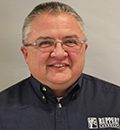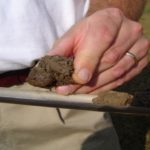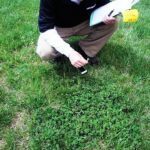By Joe Ketterer, Director of Quality and Efficiency
 Turf renovation—comprised of aeration, topdressing, liming and overseeding operations—is a process that takes place when air temperatures cool but soil temperatures are still warm, in late summer or early fall. However, mid-summer is the time to start taking proactive steps to get the best return on your investment and increase the chances of having good germination and development of the newly seeded grasses come fall, beginnig with a turf evaluation to identify deficienties or problematic areas that need to be addressed in order to support a healthy stand of turfgrass.
Turf renovation—comprised of aeration, topdressing, liming and overseeding operations—is a process that takes place when air temperatures cool but soil temperatures are still warm, in late summer or early fall. However, mid-summer is the time to start taking proactive steps to get the best return on your investment and increase the chances of having good germination and development of the newly seeded grasses come fall, beginnig with a turf evaluation to identify deficienties or problematic areas that need to be addressed in order to support a healthy stand of turfgrass.
What are some reasons to perform turf renovation for our customers?
- Poor growth and establishment following initial installation
- Loss of color and density due to drought, insect or disease pressure. Loss of density can lead to the spread of opportunistic crabgrass, nutsedge and summer annual broadleaf weeds filling in the resulting voids. An old industry adage says, There’s always something that will grow where turfgrass won’t.” There are times where standard chemical control programs are simply not able to provide sufficient levels of weed control and specialized supplemental applications are deemed necessary.
- Excessive damage from construction or utilities resulting in erosion, or compaction from pedestrian traffic.
- To introduce new and genetically improved varieties of grass seed, strengthening existing turf density so it can better serve as a bio-filter, helping keep our waterways and estuaries clean
 Once you determine a need for turf renovation, there are two things that you should do right away to get the process headed in the right direction. First, you should take a soil test to determine:
Once you determine a need for turf renovation, there are two things that you should do right away to get the process headed in the right direction. First, you should take a soil test to determine:
- Nutrient levels: In particular, phosphorous and potassium are crucial to seedling development. The recommendations provided with soil test results will determine if an additional starter fertilizer is necessary in accordance with nutrient management laws.
- pH levels: The desired pH range, at which nutrients in the soil profile are most readily available to the plant, is 6.0 to 7.0. If pH levels are low, you would apply lime to raise the pH, and if levels were high, you might consider elemental sulfur to lower the pH.
- Cation Exchange Capacity (CEC): This essentially is a measure of the soil’s ability to attract and hold nutrients. Soils with low CEC (excessively sandy soils, for example) typically need to have organic matter added to raise their CEC so that they can capture and retain nutrients. Topdressing, in conjunction with aeration, prior to overseeding at ½ to 1 inch of a 50/50 mix of compost and screened topsoil can dramatically improve success in those stressed out areas.
The importance of soil testing and maintaining the proper balance of soil chemistry cannot be overstated, as it is a key component to the success of basic aeration and overseeding operations. Too often, this important step is overlooked because of the time it takes to get results and recommendations back from an appropriate and dependable soil testing lab. The actual cost of the test is insignificant when compared to the cost of a failed turf renovation.
 Second, coordination of the mowing and overseeding schedules with the turf chemical applications is key to a successful renovation in order to reduce weed competition and pave the way for the newly germinated seedlings. Chemical applications should be scheduled two to four weeks ahead to allow time for herbicides to “break down” and not negatively affect germination of the new seed.
Second, coordination of the mowing and overseeding schedules with the turf chemical applications is key to a successful renovation in order to reduce weed competition and pave the way for the newly germinated seedlings. Chemical applications should be scheduled two to four weeks ahead to allow time for herbicides to “break down” and not negatively affect germination of the new seed.
In short, the time to start thinking about turf renovation is now, and this begins by walking the site with our customer and identifying needs, clarifying expectations, taking soil tests, making additional recommendations, and proactively scheduling turf chemical application as needed. It is a process of sequential events that requires attention to detail in order to get the best results from your fall turf renovation efforts.